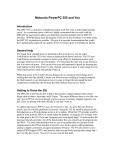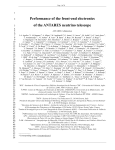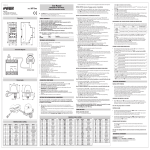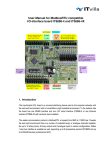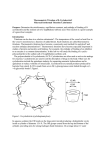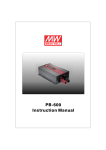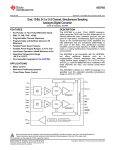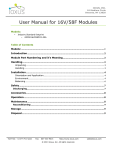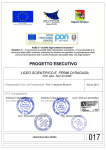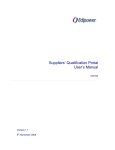Download STBCFG01 final - Arrow Electronics
Transcript
STBCFG01, ST's new highly integrated switch mode Li-Ion battery charger Agatino Alessandro, Adele Castorina, Giorgio Catanzaro, Barbaro Marano, Federico Musarra ABSTRACT Today’s portable applications are integrating ever more multimedia functions, each with different power needs. Battery charge indicators – or fuel gauges - have become essential for managing devices such as smartphones, laptops or digital cameras. Accurate “time remaining” predictions enhance the user’s experience, and can be critical in certain types of portable electronics such as medical devices. ST has combined a powerful and configurable switching battery charger with an accurate Voltage mode Fuel Gauge to simplify charging and battery monitoring. INTRODUCTION First in the world, the STBCFG01 switch mode battery charger for single cell Li-Ion batteries integrates a highly accurate voltage mode fuel gauge to monitor the battery’s state of charge. The device also provides a 5 V output to supply USB OTG (OnThe-Go) bus powered devices in addition to an LDO linear voltage regulator to support system boot in dead battery conditions. STBCFG01 uses accurate measurements of the battery voltage which allows the estimation of the battery’s state-of-charge (SOC) without a current sensing resistor. The switching charger works together with the fuel gauge to simplify monitoring features and to save current consumption when the device is not charging. The battery charger features a smart input current limit: the maximum input current can be selected through the I²C interface, and if the input voltage drops below a programmable threshold, even if the selected maximum current limit current has not been reached yet, the dynamic input current limit function is activated preventing the input current from increasing further. The dynamic input current limit function can be disabled, if necessary. An automatic input pre-bias load makes the device suitable for applications using voltage sources requiring a minimum external load for the correct regulation. A user level I²C interface lets a microcontroller configure all the functions of the device easily. Figure 1 shows the device’s simplified block diagram. All of this is packed into a space-saving 2.3 x 2.2 mm2 CSP that makes the STBCFG01 an ideal fit for all portable and wearable applications where size, efficiency and cost are of major concern. silicon temperature through dedicated sensing structures. Additionally, to accommodate the evolution of lithium battery technologies, the regulated battery floating voltage can be programmed from 3.52 V to 4.78 V. The device's system architecture allows reverse use of the switch-mode buck converter, resulting in a 500mA USB on-the-go (OTG) boost regulator, and providing power for USB peripherals. The device can work up to a 100% duty cycle and blocks reverse current from battery to input when the input voltage is disconnected or is lower than battery voltage. The charger uses an innovative architecture where the analog comparators needed to manage the charging cycle have been implemented in a digital way using the fuel gauge’s ADC converter, ensuring a high accuracy and reducing the device dimensions. The usage of the fuel gauge as an accurate voltmeter allows a voltage loop accuracy up to 0.5% through an auto adjustment strategy. Figure 1 - Architecture of STBCFG01 Charging Cycle To protect the battery and maximize mobile device usage time, the STBCFG01 implements the charging cycle in 5 phases (see Figure 2): tickle charge, pre-charge, fast charge, constant voltage (CV), and end of charge. • STBCFG01’s FEATURES Charger Architecture The STBCFG01 employs a high-efficiency DC-DC synchronous buck converter, operating at 2MHz or 3MHz, capable of supplying 1.25 A. The switching frequency can be selected through the I²C interface. The device integrates several control loops regulating the output current and voltage, the input current and voltage and • Trickle charge: when the battery is deeply discharged (< 2V) the device is in trickle charge mode and charges the battery in linear mode with a low current, around 45mA up to the trickle charge threshold. This mode is used to wake up batteries in dead battery conditions (the internal battery pack’s protection switch is open). Pre-charge phase: as soon as the battery voltage enters the pre-charge range (2V < VBAT < 3V), the device starts the switch-mode charging and increases the charging current up to the pre-charge current level (100mA or • • • 450mA, selectable) to make the system voltage rise quickly up to a level that allows the system to wake up. Fast-charge phase: When the battery voltage is above the pre-charge threshold (VBAT > 3V), the STBCFG01 enters the fast-charge mode and increases the charging current up to the IFAST value, which can be programmed up to 1.25A. Constant voltage phase: when the battery voltage reaches the programmable floating voltage threshold (VFLOAT, 3.60V to 4.70V in 20mV steps), the battery voltage is kept constant and, as a consequence, the charging current starts to decrease. End of charge: during the CV phase when the charging current reaches the termination current threshold (ITERM, programmable from 50mA to 300mA in 25mA steps), the charging process is stopped. All the transitions between each phase are managed in a smooth way. Figure 2 - STBCFG01 charging cycle The Over Voltage Protection (OVP) circuit protects the USB port when the IC is providing power in boost mode. Output short circuit protection and coil’s peak current protections are also implemented. In order to avoid excessive battery voltage drop in boost operation, the OTG mode also features a programmable input average current limit. Battery Fuel Gauge The voltage mode fuel gauge provides an accurate evaluation of the Lithium-Ion battery’s state of charge. At power-up, the fuel gauge algorithm uses the voltage reading to provide a first evaluation of the SOC based on battery modeling data. The evolution of voltage is then used to track the changes of the SOC while cycling the battery. The external software driver performs the temperature compensation. The fuel gauge block can be adapted to different batteries. Programmable parameters are used to tailor the algorithm to each battery model. In order to keep the optimal performance and avoid losing information learned during battery cycling, the user is supposed to save data contained in the device's volatile memory when power is removed. The same data has to be restored at power-up. The STBCFG01 also provides programmable alarms to notify low battery voltage and low SOC conditions. To enhance fuel-gauging accuracy with an error of 0.5% and to reduce current consumption (25uA), a 14-bit Delta-Sigma modulator using switched capacitors (SC) technique with fullydifferential input-output structure is implemented. The ADC also reduces errors through state of art techniques such as nested choppers and a digital moving average filter. The device is fully programmable to be adapted to different batteries. STBCFG01's EVALUATION TOOLS Other charger functions performed by the device are battery detection and automatic recharge when battery voltage falls below a threshold after the end of charge Battery charger temperature and charging state are fully monitored for fault conditions. In the event of battery over-voltage, charger timers’ expiration, battery failure, and the condition of battery voltage higher than input voltage, the charging process is stopped and an interrupt signal can be generated. The charger is stopped also in case of input under-voltage, input over-voltage, and silicon over-temperature. STBCFG01’s evaluation board The STEVAL-ISB033V1 (Figure 3) provides full access to STBCFG01’s functions and allows the user to quickly set-up an evaluation bench to test the device performance in a real world application. Figure 3 - STEVAL-ISB033V1 OTG Architecture The STBCFG01 features a bidirectional switching power manager that can power an application and charge the battery using the USB connector’s voltage as input source. Operating in reverse mode, the same switching regulator can take power from the battery to generate 5V on the USB connector and deliver up to 500mA for USB OTG applications without any additional components. The boost converter that implements the OTG function is a peak current mode control with slope compensation. The compensation network works at 2MHz or 3MHz. A controlling technique of pulse width modulation (PWM) mode and pulse frequency modulation (PFM) mode keeps the high efficiency within width range of loading. The board includes all passive components needed for proper operation and provides several test points to monitor the device’s voltage levels. Header connectors give access to the I²C interface and digital IOs and allow connection to the power supplies. A micro-USB receptacle can be used to supply the board from a USB port or wall charger. interface to access all the device’s configuration registers and monitor their status. The interface board (Figure 5) uses the USB interface to connect to the PC running the control software while the I²C bus is used to control the STBCFG01 evaluation board. Figure 4 - STEVAL-ISB033V1 schematic diagram Figure 5 - USB-GPIO Interface board The STBCFG01 GUI is arranged in four different tabs. The “Application” tab (Figure 6) provides a quick overview of device status, battery voltage and SOC. A typical application diagram is displayed as well. This tab also includes the enable button of the Auto Read function which continuously reads the whole register set to keep up to date the data displayed by the interface. Figure 6 - STBCFG01 GUI: “Application” tab In order to get optimal charging and fuel gauging performance, the battery header connector (J9 in Figure 4) has two voltage sensing pins used to connect the battery voltage sensing lines as close as possible to the battery pack’s positive and negative terminals. This allows the voltage drops generated by the charge/discharge current over PCB tracks and connecting wires to be removed from the battery voltage evaluation. The effect of voltage drops is twofold: when charging, if voltage drops are included in the battery voltage measurement, the start of the charging cycle’s constant voltage phase (CV, see Figure 2) is anticipated. The VFLOAT threshold (target charging voltage) is reached when the actual battery pack voltage is lower than expected (measured voltage = Vbat + Vdrop), generating an increase of the charging time that can be significant when the charging current is high. From the fuel gauge point of view, the voltage drop during both charging and discharging generates an offset that can significantly impact the accuracy of the SOC evaluation. The battery header connector also contains the battery detection pin (RID) used to detect the battery connection/disconnection. This function is very important as it allows the fuel gauge to provide an accurate starting point for the SOC evaluation algorithm when the battery is inserted or in case of battery swap. The RID pin must be connected to the battery’s identification resistor contact or to the battery’s NTC thermistor contact. STBCFG01’s evaluation software The STEVAL-ISB033V1 can be used to evaluate the device’s performance directly in the customer’s application but, on request, the USB-GPIO Interface board and the “STBCFG01 GUI” control software can be shipped. This combination provides a user friendly The “Fuel Gauge Reg.” tab (Figure 7) gives access to the fuel gauge registers. From this tab, the user can enable/disable the fuel gauge function, read fuel gauge data (Battery voltage, SOC and Open Circuit Voltage), and fine tune the fuel gauge algorithm through the VM_CNF parameter. Full control over battery voltage and SOC alarms is also provided (alarm enable, threshold setting and clear command). Status of alarm bits and battery connection detector is displayed. The OTG mode enable control bit is included as well. Similarly, the “Charger Reg.” tab (Figure 8) contains all the registers needed to control and configure the battery charger, grouped into two sub-tabs (reg. addresses 0x90 to 0x95 and 0x96 to 0x9A). All the charging parameters (charging current, charging voltage, input current limit…) and special charging functions can be set up from this tab. Charger status information is also provided along with full interrupts’ configuration. Figure 7 - STBCFG01 GUI: "Fuel Gauge Reg." tab During the constant current phase, the charging current is at its maximum value and the battery voltage increases. When the battery voltage reaches the target voltage (VFLOAT), it is kept constant while the current tapers down until it reaches the termination threshold. With reference to Figure 10, the decreasing trend of the charging current is due to the battery pack’s internal impedance (RI) and the parasitic resistance from the battery terminals to positive and negative sensing terminals of the charging device (RP2 and RP3). While the charging device keeps the voltage between battery voltage sensing terminals constant (VSENS), the internal battery pack’s voltage (VCELL) keeps increasing during the constant voltage phase. This makes the drop across the battery’s internal impedance and parasitic resistance (RI+RP2+RP3) decrease and therefore the charging current also decreases. Figure 10 - Charging system parasitic effects Figure 8 - STBCFG01 GUI: "Charger Reg." tab Finally, the “LOG” tab displays a list of all the operations executed and the version of the USB-GPIO Interface board’s firmware. A complete GUI user manual is available for further details. STBCFG01’s charging performance Figure 9 shows a typical charging profile where VBUS is the charger’s input voltage, IBUS is the charger’s input current, and VBAT/IBAT are battery voltage/current. Figure 9 - Typical Li-Ion battery charging cycle As already mentioned in this article, the voltage drop over RI, RP2 and RP3 also makes the charger enter the CV (constant voltage) phase earlier than expected (before VCELL reaches VFLOAT), generating an increase of charging time at high charging current level. In order to mitigate this phenomenon and extend the duration of the constant current phase, the STBCFG01 enters the CV phase when the sensed battery voltage is slightly higher than the target voltage. Once the CV phase has started, the target voltage is automatically set down to the nominal battery charging voltage. This can be seen in the charging profile in Figure 11. When the CV phase starts, the charging voltage (red curve) decreases to the final value. The charging current drops accordingly. Figure 11 - STBCFG01 charging profile STBCFG01’s fuel gauge performance An accurate evaluation of a Lithium Ion battery’s state of charge (SOC) is very important in mobile applications. It provides the end user with an estimation of remaining battery life, which is critical information when the state of charge starts approaching the dead battery threshold. Accurate SOC evaluation helps avoid sudden and unexpected device shut-down and allows the device’s operating system to store important data before the system cut-off voltage is reached. In a relaxed Lithium Ion battery, there is a univocal relationship between the SOC and the open circuit voltage (OCV). A battery is considered to be relaxed when a specific time period (tRLX) has passed since the last high current charge/discharge operation (| I | > IRLX). IRLX and tRLX, along with the relationship between SOC and OCV, are parameters linked to the specific battery chemistry. Figure 12 shows a typical SOC/OCV curve for a high capacity 4.35V Li-Ion battery. using the STBCFG01 in a mobile phone application. The error curve is obtained by comparing the SOC calculated by the STBCFG01 and the ideal SOC. The latter is calculated using a high precision amperometer, to measure the current flowing into the battery (charging) or out of the battery (discharging). The error is well below ±5%, a very good performance for a voltage mode fuel gauge. Figure 13 - OCV to SOC error Figure 12 - Open Circuit Voltage vs State of Charge Figure 14 - Fuel Gauge accuracy during charging The STBCFG01 uses the OCV curve to detect the battery’s SOC when the battery is first plugged in to the application and then continuously monitors the battery voltage to determine the evolution of the SOC. The starting point of the SOC is evaluated once again each and every time a battery disconnection is detected combining the information of battery voltage and RID input. A generic OCV curve is stored in a LUT inside the STBCFG01, but in order to reach accuracy, the battery to be used in the application must be characterized to extract OCV curve and adjustment parameters. It can be observed in Figure 13 that an accurate reading of the OCV is mandatory to achieve an acceptable error in the initial SOC evaluation: the curve shows a very low slope portion where a small error in the OCV reading (∆V) translates into a big error in the SOC (∆SOC). For this reason, the STBCFG01 integrates a high accuracy 14bits delta-sigma modulator into the fuel gauge block. STMicroelectronics must be contacted for details about battery characterization and LUT update routine. Figure 14 and Figure 15 show typical accuracy performance extracted from real charging and discharging cycles Figure 15 - Fuel Gauge accuracy during discharging CONCLUSIONS In a single chip, the STBCFG01 combines a high efficiency switching battery charger and a voltage mode fuel gauge. The single chip solution saves PCB space and a number of external components. Without needing any external sensing resistors, the voltage mode fuel gauge provides good accuracy with its high precision ADC converter and high performance fuel gauging algorithm. The high number of programmable charging parameters in a compact package together with a fuel gauge function make the STBCFG01 a very cost-effective solution for middle-end smartphone platforms and medium battery capacity mobile applications. REFERENCES [1] STBCFG01 Datasheet: “Switch mode single cell Li+ battery charger with OTG boost, voltage mode fuel gauge and LDO” – June 2014 http://www.st.com/st-webui/static/active/en/resource/technical/document/datasheet/DM0012 1014.pdf [2] STBCFG01 GUI: Windows Based GUI to Debug by I2C Bus the STBCFG01 Device (Programmable Li-Po Battery Charger) – March 2013






